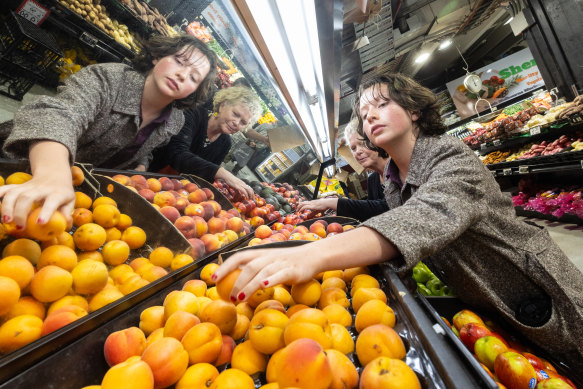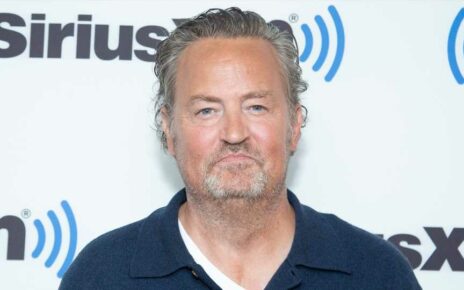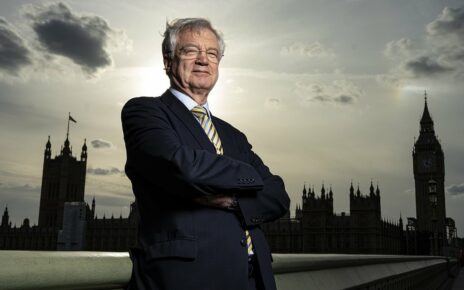Save articles for later
Add articles to your saved list and come back to them any time.
The financial hit from rising interest rates and high inflation has obliterated nine years of gains for Victorian households, taking the amount of money families have at their disposal back to 2014 levels.
Families are now sharply scaling back on spending on non-essentials such as eating out and entertainment to cope with the added pain.
Gwen Utano and her mum Rebecca Overbury shopping. The latest inflation figures show fruit and vegetable prices are up, in part due to a reduced supply of melons and bananas.Credit: Jason South
Real disposable household income per capita in Victoria – a key measure of the amount of cash available per person after adjusting for rising prices – has fallen to the lowest level since June 2014, shortly after then prime minister Tony Abbott famously declared a “budget emergency” and announced spending cuts and savings measures.
Victorian households had $52,209 per person in disposable income over the year to June 2023. That was well below the average for Western Australia, New South Wales and Queensland, and only slightly above Tasmania and South Australia.
South Australia is the only state to have suffered bigger losses, with the financial position of the average family wound back to the lowest level since June 2010 levels in real terms.
Queensland families were pushed back to the lowest level since June 2019, NSW families to the lowest since June 2018 and West Australian families to June 2020 levels in real terms.
The figures stand at odds with other data suggesting the state economy remains relatively robust, including a state unemployment rate of just 3.6 per cent in trend terms, the lowest for the state since the current monthly series started in 1978.
But the gains are not being evenly shared. The figures, based on an analysis of Australian Bureau of Statistics data by The Age, confirm what many Victorian families already know: that the most aggressive interest tightening cycle in recent history coupled with other cost of living pressures and years of sluggish wage growth has had a crippling impact.
While spending on essentials like health care and transport has soared, households are cutting back dramatically on discretionary items such as recreation and restaurants.
In a sign that many households are now desperately reining in their spending, a new experimental measure relying on bank transactions data shows Victorian households cut back discretionary spending by 3.9 per cent over the year to October – the largest fall of all the states and territories.
On the other hand, so-called non-discretionary spending in Victoria rocketed up by 8 per cent over the year, including a 10.5 per cent increase in health spending and a 16.1 per cent increase in transport spending.
State Treasurer Tim Pallas urged the Reserve Bank to “step back” and consider the cumulative impact of high interest rates before making further decisions that could add to stresses on household budgets.
“We know interest rate rises have a real impact on household budgets and that’s why we provide support when and where we can,” he said. “I’d urge the Reserve Bank to step back and look at the cumulative effect of rate rises before making any future decisions on the appropriate level of interest rates.”
Independent economist Saul Eslake said on several measures Victoria had become a relatively poor Australian state, with a return to strong population growth following the pandemic leaving economic gains for the state spread more thinly.
Eslake said households across the state had been squeezed by rising interest rates, rising personal tax payments and falling real wages due to cost of living pressures. But he also warned the state economy had once again come to rely on strong population growth, which was undermining real living standards.
Independent economist Saul Eslake: ‘Victoria’s productivity is the third worst in the country, ahead of only South Australia and Tasmania.’Credit: Amy Brown
He said the state’s productivity performance – typically measured by the amount of economic output generated per hour worked – was 12.7 per cent below the national average.
“Victoria’s productivity is the third worst in the country, ahead of only South Australia and Tasmania,” Eslake said.
“Victoria has actually become by many metrics a poor state. In 2022-23 Victoria’s gross state product per head was 13 per cent below the national average, whereas recently as 2004-05 it was above the national average.
“The point is, if you look at top-line growth, Victoria’s is respectable, but it’s been driven by population.”
Victorian Council of Social Service (VCOSS) chief executive Juanita Pope said the cost of living crisis had not hit all families evenly. She said governments needed to target assistance to people and communities most in need, with many families unable to afford basics such as housing, food, medicine and school costs.
“High inflation, interest rate rises, surging rents and low wages growth are upending household budgets, especially for low-income earners and people on income support,” Pope said. “Nobody should have to choose between feeding themselves or using electricity in the home.”
Economic modelling prepared by the National Centre for Social and Economic Modelling and published by VCOSS shows there are almost 800,000 people in Victoria living in poverty, representing about 13.3 per cent of the state. Increases in poverty in Greater Melbourne were offset by some reductions in regional and rural areas, with higher concentrations of poverty found in the outer northwest, west and southeastern suburbs of Melbourne.
Get the day’s breaking news, entertainment ideas and a long read to enjoy. Sign up to receive our Evening Edition newsletter here.
Most Viewed in National
From our partners
Source: Read Full Article




